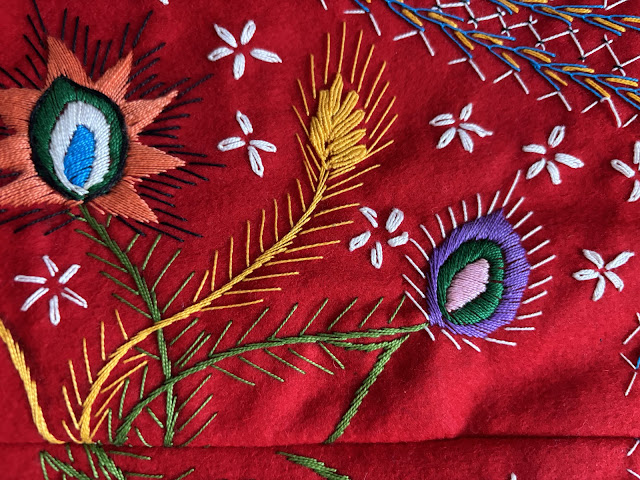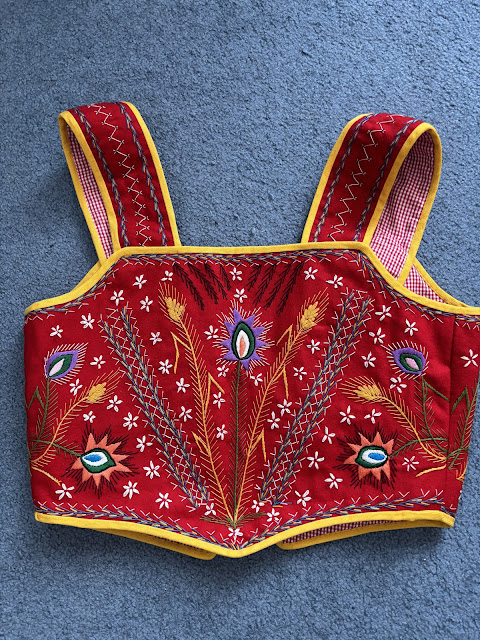Hello all,
Today I will focus on the folk costume of the town of Orotava, on Tenerife, in the Canary Islands, Spain.
These islands are located off the coast of Morocco. The Canary Islands had an indigenous population of Berber origin, today called Guanches. They were quickly assimilated by Spanish colonists in the 17th century, and their language is extinct, except for some influences they had on the local dialects.
The common name for these islands is from the Latin 'Canariae Insulae', The Dog Islands, referring perhaps to the large number of seals found there. Canary birds are indeed native to the islands, but they are named after the islands, not the other way around.
https://en.wikipedia.org/wiki/Canary_Islands
Here are a couple of maps showing the location of the Canary Islands.
Tenerife is the goose shaped island just west of center. It is the largest of the islands.
.png)
The image at the head of the article is of some of the various Folk Costumes of Tenerife. You can see that there is some commonality between them.
The embroidery seems to have been introduced by one woman, Doña Catalina Monteverde y Lugo, whose family had a camisa embroidered with white and red hemstitching. This was admired and widely imitated. The old costume of the Monteverde Family is shown in the center of this photo.
A small linen shawl, pañuelo del hombros, about 85cm square, is commonly worn for modesty and for protection against the sun. Pietistic influences have impinged on Spanish clothing since the 19th cent. This shawl is usually white, sometimes with subtle stripes or embroidery.
But here is a photo of a woman who tucked it into the camisa, presumably to show off the embroidery.
A full linen petticoat, enagua interior, is worn, often more than one. A red flannel one may be worn underneath, for warmth and/or protection. This protects the wearer from the scratchy wool overskirt, and also protects the skirt from oils in the wearer's skin, linen being much easier to launder.
There are many stripe patterns, depending on the town and the island, but the skirts for La Orotava have a pattern with red, yellow, white, green, and black stripes on the weft. As you can see above, there is always a seam about 1/4 of the way from the waist to the hem. This is due to the fact that hand looms are very difficult to operate at a wide width. The panels were about 60 cm wide, and so another partial width was added to make the skirts long enough. Mostly, they make no attempt to match the stripes, as we see above, but occasionally one sees that someone made such an effort. However, this is the exception.
The material is so heavy that there is no attempt to fold it over at the hem. Rather the cloth is cut at the hem and secured by seam binding. A facing is added inside the hem for optimization of movement, and this is also secured by the seam binding, which is usually red or yellow.
The bodice, although it may be of a patterned material, is not usually embroidered in other parts of the Canaries. While the motifs are similar, the composition of the embroidery varies quite a bit. This first image is of a replica of the original justillo of the Monteverde family, followed by details from a vest owned by a friend of mine.
The costume is currently worn with specific beige button half boots. It may be worn with various other types of leather shoes as well.
A rectangular cotton kerchief, 51 x 93.5 cm, called toca, is worn over the head. The edges of this may have subtle embroidery. This may be pulled tight under the chin or thrown back over the shoulders. See the various images above.
A short green cape, capotillo, is worn over the shoulders. It is of green wool, 81 cm long and 125 cm wide. It is edged with yellow seam binding, and is gathered into a band on top and secured with ribbons.
A video showing how to put on the old style Canary Costume. This is not the La Orotava costume, but gives you a good idea.
https://www.youtube.com/watch?v=sMqd6tn5GZA
Just as the preservation of the traditional costume was due to the Monteverde Family, the invention of the new costume was the result of the efforts of the Baute Family. Three sisters, Ángeles, Eudalia, and Carmela Baute Rodríguez redesigned the costume for the newly formed performing group 'Coros y Danzas de La Orotava' in the 1950's. Their grandmother had started a sewing business which specialized in making stage costumes for magicians and their assistants, although they sewed other things as well.
They apparently thought that the traditional costume was not flashy enough, and so set out to make it more 'suitable' for the stage.
The hat often became smaller, to the point where they may be no larger than 10 inches across, and often worn at an angle.
The toca and pañuelo del hombros were combined into one smaller kerchief, el pañuelo de cabeza. This is now yellow, and wrapped around the head and neck and tied in back, leaving the neckline bare. The hair is still put up before putting on the headdress.
The capotillo was made somewhat shorter, and the front corners rounded. The rounded corners are a characteristic of many stage costumes which I find inexplicable. It is now usually worn over one shoulder.
The skirt was shortened, and is worn hiked up on one side, held in place somehow by a cord decorated with pompoms. As a result the petticoat now has elaborate crochet or other lace with zigzag ends on the hem and eyelets threaded with red ribbons above that, sometimes more than one row, although upper rows are often restricted to the side on which the skirt is hiked up.
A small, rounded, "French Maid" style apron, el delantal, was added to the outfit. This is trimmed with lace, patch pockets and red embroidery and/or ribbon in a similar manner to the petticoats. [I will admit that appreciation of this garment escapes me]
The vest, justillo, was changed subtly in shape, the straight lines giving way to rounded lines, especially over the bust. It continues to be richly embroidered, with much individual interpretation.
Here is a video of how to put on the new costume, entitled "How to dress like a magician", referring to the Baute Sisters.
https://www.youtube.com/watch?v=Zojq7-qZvSM
Here are some more images of this outfit.
Here is a suite of dances from this area, performed in the new costume.
Roman K.
email: rkozakand@aol.com
Source Material:
There is valuable information on this website:
https://www.oroval.com/traje-tipico-de-la-orotava/
Juan de la Cruz, 'Los Trajes Tipicos de la Orotave', Orotava, 2008
Juan de la Cruz, 'Las Indumentarias Tradicionales de Canarias', La Laguna - Tenerife, 2002
Manuel Perez Rodriguez et al, 'Trajes Tipicos - Guia de Vestimenta Folklorica de Canarias', La Laguna - Tenerife, 1998
Lorena Delgado et al, 'Iconos de Estilo - Una Mirada a la Indumentaria Tradicional' Museo del Traje, 2018






.png)

















.png)




















































































I must agree with you, Roman, on both counts - long sleeves and old costume are more elegant! Thanks for the post. Charlotte in California
ReplyDeleteWonderful!
ReplyDeleteWonderful job. I really enjoyed this blog of yours, Too cool to have like this
ReplyDeleteA great read. Thank you for sharing this fascinating information. Best of luck
ReplyDeleteYour writing style content is awesome. keep it up! Nice one! Thank you for sharing
ReplyDeleteCustom Packaging in Los Angeles
ReplyDeleteLooking for unique custom packaging in Los Angeles? We offer a wide range of high-quality, customizable packaging solutions to elevate your brand. Whether you need custom boxes, bags, labels, or wrapping, we provide products designed to enhance your brand identity and create a memorable customer experience. Our team works closely with you to bring your vision to life with the latest design techniques and materials. With quick turnaround times and competitive pricing, our custom packaging services are perfect for businesses looking to make a lasting impression of Custom Packaging Los Angeles market. Let us help you stand out!
where would one go too purchse these costumes?
ReplyDelete